Florence Between 1370 and 1430
The first floor (or second, depending on where you’re from) of the Accademia is surely less crowded than the ground floor: it was completely reorganized in 2013, housing a collection of late 14th century Florentine paintings, ranging between 1370 and 1420. The environment is very peaceful and enjoyable with its renewed lighting, perfect to admire recently restored masterpieces of late Gothic Florentine period.
Vestibule
The visit of the first floor begins from artworks which explain the Florentine religious devotion in the late fourteenth century. In the small vestibule, one can admire panels by Jacopo di Cione and a stunning gold backed Madonna and Child by Don Silvestro of Gherarducci.
The most touching work is the “Massacre of the Innocents” by Jacopo di Cione’s workshop. The work comes from the monastery of St. John the Evangelist Boldrone in Florence and is part of the three episodes from the childhood of Christ narrated on the same panel. The painting presents in the upper register the heartbreaking “massacre of innocents”, which is described in detail both in the clothes and in the expressions of mothers who try to protect their children or despair in front of the lifeless little bodies. In the lower register one can recognize the Adoration of the Magi and the Flight into Egypt, left to right, described with a vivacity that aimed to be clearly understood by the illiterate masses. There are fashionable garments worn by the three kings, women and soldiers, while a patron is depicted in small size in front of St. Joseph. Behind the Magi you can recognize a servant who takes a blindfolded falcon, a typical element that is usually depicted in the hunting scenes of Florentine nobles.
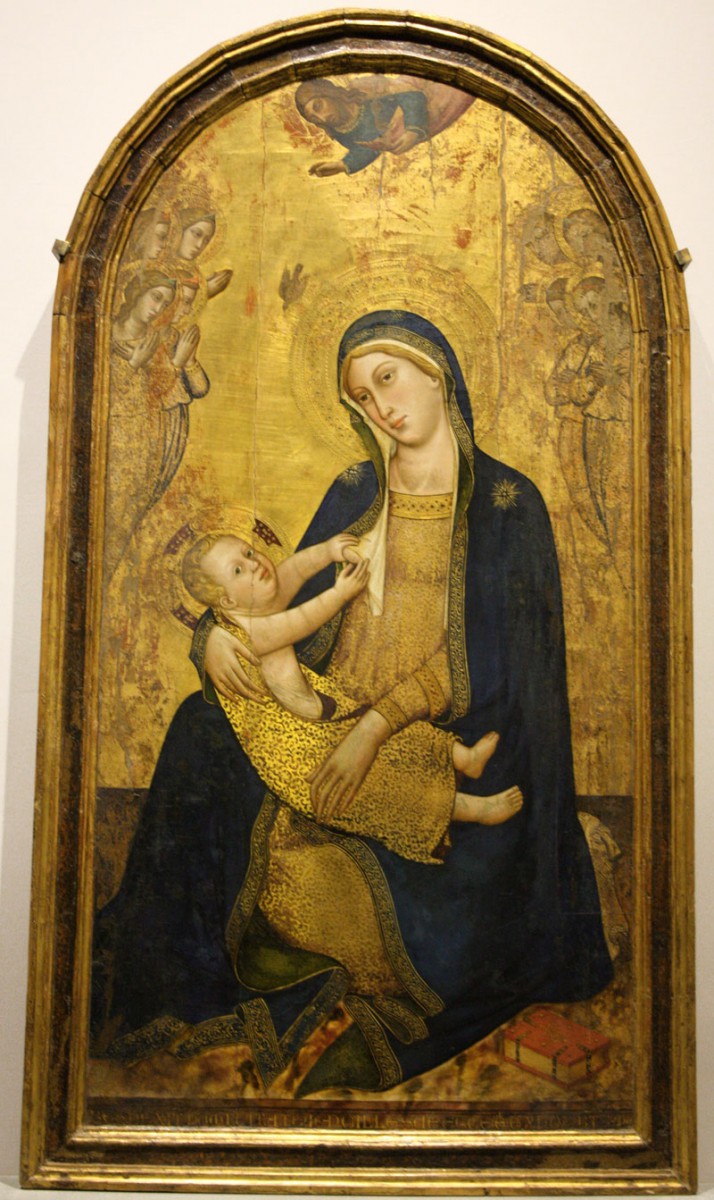
Gherarducci’s “Madonna of Humility”
Very tender, however, is the representation of the “Madonna of Humility” by Don Silvestro Gherarducci. The Virgin is depicted sitting on a cushion on the floor, rather than raised on a monumental throne. The word “humility” in fact has its roots in the Latin word “humus”, which means “earth.” Mary holds the Child in her arms, who tenderly searches for his mother’s breast. The painter, Don Silvestro of Gherarducci, was a Camaldolese monk, living at the Florentine monastery of Santa Maria degli Angeli, where he also practiced the art of miniature. His technical mastery is recognized in the many marks of the punches used to ornate the fine robe and the refined blue mantle edge, which make the painting extremely precious.
Fashion in the 14th century
The video projected in the vestibule shows in detail the features of 14th century fashion, which played a very important role with the birth of the middle class during the course of that century. The garments for both women and men were long and wide, falling to the ankles as depicted in many paintings on display at the Accademia Gallery. The fineness of the wool and silk fabrics highlights their membership in the high social classes, becoming a privilege of aristocrats and rich merchants. Smocks and capes were often worn over clothes lined by ermine or squirrel fur.
Main Hall
The central spacious lounge allows the visitor to appreciate the importance of the commissions of the Florentine Guilds and the magnificence of the altarpieces made between the late XIV and early XV century. The social-economic and devotional aspects of the Florentine society are presented through the large format paintings commissioned by some of the richest of the Florentine Guilds for the altars of churches and monasteries in the city. The large altarpieces feature rich gilt frames decorated with pinnacles, spires, pillars and shrines, whose slender forms refer to the refined and elegant Gothic architecture. As their importance (or desire for importance increased), so did the number of figures in the paintings, with more crowded compositions and figures of saints who wear stylish trendy clothes, like a rich princely procession. The best known artists exhibited in the central hall are Giovanni del Biondo, Mariotto di Nardo, Spinello Aretino and a core of Lorenzo Monaco paintings of exceptional quality.

The viewer is welcomed by two patrons of the Guilds: on the right St. John the Evangelist, the patron saint of the Guild of Silk, is portrayed defeating the allegory of greed, pride and lust. In the scene below, one can distinguish the coat of arms of the Guild, a gate, which symbolizes the old location of the Guild in Via Por Santa Maria and the rule of maintaining the secrets of silk production, handed down jealously by members of the guild to other members. On the left, the dominant panel depicts St. Martin, patron of winemakers whose emblem, a cup, is depicted in the predella of this painting. The tall, narrow shape of the panels fit perfectly to the pillars of the Church of Orsanmichele, which was decorated by artworks sponsored by the Guilds.
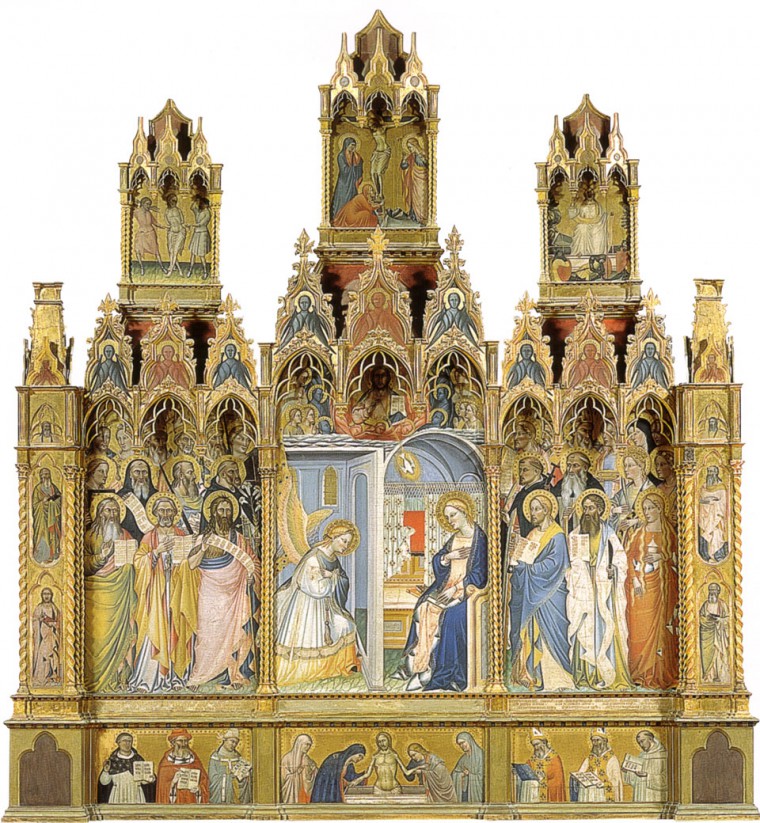
Giovanni del Biondo, “Annunciation with the Blessing God Father”
One of the most complex and grandiose altarpieces is signed by Giovanni del Biondo: the main subject is the Annunciation with the Blessing Father surrounded by a multitude of angels and saints placed in several of the altar’s peaks. The large artwork comes from the convent of Santa Maria Novella in Florence, where it adorned a burial chapel dedicated to the Virgin of the Annunciation. On either side of the central panel, you can find many saints depicted in stylish garments, easily identified by the names inscribed on the base. The lack of knowledge of writing, familiar only to the clergy, notaries and aristocrats, made it necessary to use a simple, figurative language that everyone would easily understand the subjects. Painters therefore followed a set of symbols connected to each saint’s martyrdom, including objects, gestures and colors which became attributes of each of the saints.
For instance, St. John the Baptist is recognizable by the camel fur and the cross, St. Peter by the keys, Mary Magdalene with her long hair and red cloth, Saint Catherine by the wheel of her martyrdom.
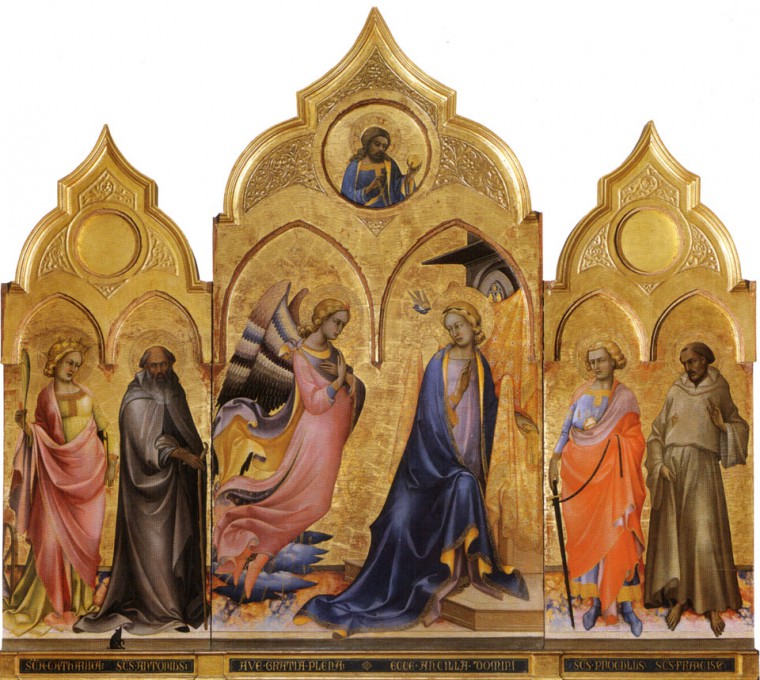
Lorenzo Monaco, “Annunciation”
The charming Annunciation by Lorenzo Monaco arrives from the monastery of the Florentine Abbey (across from the Bargello). The original location of the triptych was an altar of the parish church of St. Proculus, which no longer exists today. Among the saints, one can recognize the saints Catherine, Anthony Abbot, Proculus, and Francis of Assisi with God Father in the cusp. The composition is enlivened by the appearance of the elegant Archangel Gabriel in flight and the fearful gesture of the Virgin, wrapped in precious fabrics. On the right of the archangel, adorned with a glittering punched halo and a divine flame on his forehead, is St. Anthony, in a monastic long gown, with a small wild piglet at his feet. The attribute is derived from the custom of the Antonian monks to breed pigs, whose fat was used as an ointment for patients suffering from very painful stinging sores, known as “shingles”. The vibrant tones used by Lorenzo Monaco have recently been brought to light thanks to a careful restoration.
Another interesting polyptych is the one produced in 1401 by a collaboration among several artists including Spinello Aretino, Niccolò di Pietro Gerini and Lorenzo di Niccolò di Martino. Their “Coronation of the Virgin” comes from the church of Santa Felicita in Florence. The artwork witnesses the common practice by the painters of long ago of working in partnership, creating real “companies” or “workshops”. Spinello Aretino played probably the main role in the preparation of the subject of “The Crowned Virgin” depicted as Queen of Heaven crowned by the Redeemer. The sumptuous depiction was soon to symbolize the triumph of the Church. This subject is often found in altarpieces intended for female monasteries, foreshadowing the heavenly reward for a life of prayer and penance of the nuns. In the painting, it is interesting to note the variety of musical instruments played by the angels at the feet of the Virgin, playing drums, bagpipes and wind instruments.
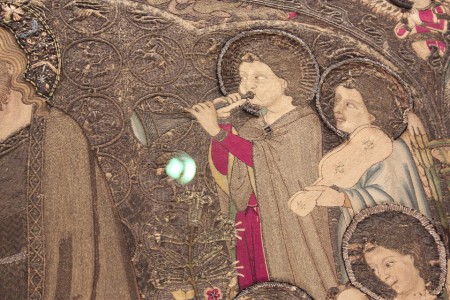
Sacred vestment, paliotto
At the end of the hall, visitors will also find a perfectly preserved masterpiece in fabric. The sacred vestment (paliotto) is a large cloth embroidered with gold and silver threads of polychrome silk that originally covered the altar of the Florentine church of Santa Maria Novella, executed by Jacopo Cambi in 1336. The work demonstrates the importance of the art of embroidery in Florence which was much appreciated during the XIV century and well known far beyond the borders of the Florentine Republic. On the far wall, you will find a large altarpiece restored a few years ago. The careful restoration has brought back the vibrant color palette used by Rossello di Jacopo Franchi for his “Coronation of the Virgin” surrounded by Saints and Angels from the monastery of Santa Maria delle Campora in Florence. The back of the three main compartments of this polyptych feature a decoration which imitates a marble covering, an element that suggests that the altarpiece was originally to be visible even from behind. The cusps are decorated with seraphim angels (blue) and cherubim angels (red).
International Gothic

Going beyond the last staircase, flanked by two painted crosses at the beginning of the XV century, the last wing of the museum houses the Hall of the International Gothic.
It collects some important works executed by Lorenzo Monaco, a well-known Florentine painter active from the end of the 14th century until the early 1420s. Lorenzo was a monk, belonging to the religious order of the Camaldolese monastery of Santa Maria degli Angeli in Florence, where he was engaged also as a skilled miniaturist, mostly working on illustrating codex.
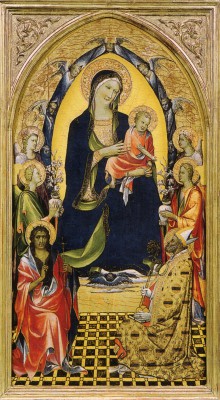
Gherardo Starnina, “Madonna with Child”
In the hall, you can also admire the Madonna and Child with Saints by Gherardo Starnina, one of the main exponents of the International Gothic style in Florence. The painter was of Florentine origin, but spent a long period of time in Spain at the royal court of Valencia. There he developed a personal, vivid figurative language which later had a great impact on his contemporaries upon his return to Florence shortly after 1400, including Lorenzo Monaco. In his exquisitely elegant works, religious devotion is expressed by each delicate figure, exalted by clear shades of blue, pink and violet which evoke the effect of a heavenly world radiant with light.
In this room, you can also follow the transformation in the shapes of altarpieces: the complex polyptychs with spires and pinnacles are gradually replaced by rectangular panels. This type of format is shown by the recently restored panel painted by the Master of St. Ives, less well known on the Florentine scene but heavily influenced by Agnolo Gaddi and Lorenzo Monaco at the turn of the 14th century. The work comes from the offices of the Community in the Palace of the Guelph party in Florence and celebrates the virtue of Justice. In the center, the artwork features St. Ives of Brittany while rendering justice to the poor, orphans and widows. The saint turns his attention to the group of poor people on the left, ignoring the lure of the nobles, richly dressed on the right of the saint. Note the contrast between the sumptuous brocade hats and vests of the aristocrats and the modest gowns or worn out socks of the orphans. Canonized in 1366, St. Ives is depicted as a lawyer, in memory of his activity as an ecclesiastical judge and his commitment to protect the rights of the weakest.
In the hall you will be able to watch the interesting video shown above that faithfully shows the stages of tempera panel painting techniques described in the “Book of the Art” (Libro dell’Arte) written by painter and miniaturist Cennino Cennini written at the end of the 14th century. The video explains the creation of a small scale model of an altarpiece, from the preparation of the wood, the gilding process and the preparation of the final painting with egg-based tempera. The term polyptych, deriving from the Greek Polu (many) and ptyche (folds), refers to a painting which consists of multiple painted panels combined into a single framed set. If divided into three compartments, the artwork is called triptych. These paintings were usually decorated by cusps at the top or pilasters at the sides. At the bottom they rested on a painted “step”, called “predella”. The various parts of altarpieces were assembled together by skillful carpenters and passed onto the painters for the “gilding” and painting stage. This ancient technique is still alive in Florence today thanks to the fascinating art restoration workshops!











